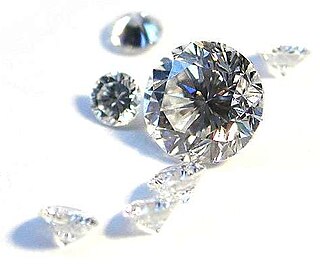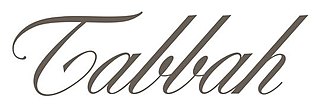
The Cullinan Diamond is the largest gem-quality rough diamond ever found, weighing 3,106 carats (621.20 g), discovered at the Premier No.2 mine in Cullinan, South Africa, on 26 January 1905. It was named after Thomas Cullinan, the owner of the mine. In April 1905, it was put on sale in London, but despite considerable interest, it was still unsold after two years. In 1907, the Transvaal Colony government bought the Cullinan and Prime Minister Louis Botha presented it to Edward VII, the British king who reigned over the territory. It was then cut by Joseph Asscher & Co. in Amsterdam.

The Gemological Institute of America (GIA) is a nonprofit institute based in Carlsbad, California. It is dedicated to research and education in the field of gemology and the jewelry arts. Founded in 1931, GIA's mission is to protect buyers and sellers of gemstones by setting and maintaining the standards used to evaluate gemstone quality. The institute does so through research, gem identification, diamond grading services, and a variety of educational programs. Through its library and subject experts, GIA acts as a resource of gem and jewelry information for the trade, the public and media outlets.

Cartier International SNC, or simply Cartier, is a French luxury-goods conglomerate that designs, manufactures, distributes, and sells jewelry, watches, leather goods, sunglasses and eyeglasses. Founded by Louis-François Cartier (1819–1904) in Paris in 1847, the company remained under family control until 1964. The company is headquartered in Paris, France, and is currently a subsidiary of the Swiss Richemont Group, a global luxury giant. Cartier operates more than 200 stores in 125 countries, with three Temples in Paris, London, and New York City.

The Jubilee Diamond, originally known as the Reitz Diamond is a colourless, cushion-shaped diamond weighing 245.35 carats, making it the sixth largest diamond in the world. It was originally named after Francis William Reitz, the then president of the Orange Free State where the stone was discovered, before being renamed to honour the 60th anniversary of the coronation of Queen Victoria in 1897.

Harry Winston was an American jeweler. He donated the Hope Diamond to the Smithsonian Institution in 1958 after owning it for a decade. He also traded the Portuguese Diamond to the Smithsonian in 1963 in exchange for 3,800 carats of small diamonds.

Diamond is a gemstone formed by cutting a raw diamond. Diamonds have high monetary value as one of the best-known and most sought-after gems, and they have been used as decorative items since ancient times.

Asprey is a United Kingdom-based designer, manufacturer and retailer of jewellery, silverware, home goods, leather goods, timepieces, and books.
Fred Joaillier, more commonly known as Fred, is a French jewellery and watch brand founded in 1936 by Fred Samuel in Paris and operated by the company "Fred Paris".
The Elizabeth Taylor Diamond, formerly known as the Krupp Diamond, is a 33.19-carat (6.638 g) diamond that was bought by Richard Burton for his wife, Elizabeth Taylor in 1968. The diamond was one of a number of significant pieces of jewellery owned by Taylor, her collection also included the 68 carat Taylor–Burton Diamond, which was bought by the couple in 1969. The diamond was sold by Taylor's estate in 2011 for $8.8 million.

Elizabeth II owned a historic collection of jewels – some as monarch and others as a private individual. They are separate from the gems and jewels of the Royal Collection, and from the coronation and state regalia that make up the Crown Jewels.

The Nassak Diamond is a large, 43.38 carats (8.676 g) Golconda Diamond that originated as a larger 89-carat diamond in the 15th century in India. Found in the Golconda mine of Kollur and originally cut in India, the diamond was the adornment in the Trimbakeshwar Shiva Temple, near Nashik, in the state of Maharashtra, India from at least 1500 to 1817. The British East India Company captured the diamond through the Third Anglo-Maratha War and sold it to British jewellers Rundell and Bridge in 1818. Rundell and Bridge recut the diamond in 1818, after which it made its way into the handle of the 1st Marquess of Westminster's dress sword.
Graff is a British multinational jeweller based in London. It was founded by British jeweller Laurence Graff in 1960. A vertically integrated company, Graff operations comprise the design, manufacture and retail distribution of jewellery and watches.
The Empress Eugénie Diamond is an oval-shaped brilliant diamond, perfectly cut, and weighing 51 carats. It is named for the French empress Eugénie de Montijo, who owned it in the late 19th century. It is currently in the hands of a private collector.
The Winston Blue is the name given to what was the largest flawless vivid blue diamond bought by Harry Winston, Inc. on May 15, 2014, from an anonymous person for $23.8 million at Christie's Geneva Magnificent Jewels sale. The approximately $1.8003 million per carat price paid for the 13.22-carat diamond is a world record for a blue diamond. Harry Winston, Inc. had also bought a 101.73-carat colorless diamond named Winston Legacy at Christie's Geneva jewelry auction in 2013. The American luxury jeweler had then paid $26.7 million for the colorless diamond, which is a world record for the highest price paid per carat for a colorless diamond.

Fred Mouawad is a Lebanese businessman from Zgharta, Lebanon and based in Bangkok, Thailand. He has founded and is the CEO of seven companies. In 2013, Wealth-X named Mouawad the eighth richest diamond owner in the world, with a net worth of $1.1 billion.

Tabbah is a bespoke jewelry company that was founded in 1862 and now is a family business owned and run by Nabil and Nagib Tabbah.

The "Star of the East" is a 94.78-carat, pear-shaped, D-color stone of VS2 clarity grade. Its exact origin is unknown, but it likely originated from India. The Star of the East diamond was part of the collection of jewels belonging to the Ottoman Sultan, Abdul Hamid II, who ruled between 1876 and 1909. The Star of the East was stolen from Sultan Abdul Hamid II. The exact circumstances under which the diamond came into the possession of the Sultan are not known. Even the origin of the name and at what point in its history it was christened remain a mystery. The diamond was part of the collection of the jewellery-loving Sultan of the Ottoman Empire, Abdulhamid II. It was later acquired by Pierre Cartier, who sold it to Evalyn Walsh McLean. After McLean's death, Harry Winston purchased the diamond together with McLean's entire collection. The diamond's current whereabouts are unknown.

Golconda diamonds are mined in the Godavari-Krishna delta region of Andhra Pradesh, India. Golconda Fort in the western part of modern-day Hyderabad was a seat of the Golconda Sultanate and became an important centre for diamond enhancement, lapidary, and trading. Golconda diamonds are graded as Type IIa, are formed of pure carbon, are devoid of nitrogen, and are large with high clarity. They are often described as diamonds of the first water, making them among history's most-celebrated diamonds. The phrase "Golconda diamond" became synonymous with diamonds of incomparable quality.
Henry Ho is a jeweler in Thailand and President of the Bangkok Diamond & Precious Stones Exchange.




















